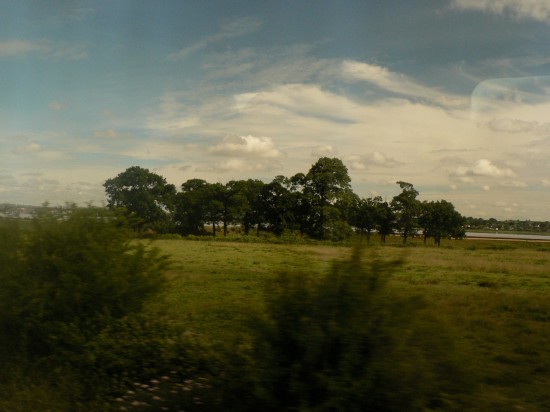As told by Ian Vince.
June lingers as long as May while April is broken into chunks of fair weather and foul, but a sunny July sweeps along, a temporal anomaly in a year of long months. The pleasures of July are all part and parcel of the business of July, namely touring with a new book – The Lie of the Land – but it also turns out to be a month of remembrance and a funeral on a warm day near its end becomes an apposite point to turn and face the past.
The hot July lends itself to memories. Kodacolor views with back-lit leaves in woodland glades, the out of focus highlights rendered into doughnut rings by chunky mirror telephoto lenses from the 1970s, the burnt gold of parched grass and a million scintillae of dust shilly-shallying in the angular light.
I have a dozen places to go in July and for someone who only sporadically leaves the office in the week, I look forward to travelling just for the sake of it. Even a short hop of the kind undertaken by millions of commuters on a daily basis becomes a journey of discovery, a personal odyssey, a peregrination of the soul, you get the idea: I really should get out more. To make the most of my traveling time, I resolve to take as many pictures of my journeys as the high-speed passing hedges and dirty windows allow.

Heading west from London in the early evening with Goldfrapp’s Seventh Tree album, the lush, compressed strings of Cologne Cerrone Houdini mesh well with the picture window video of Hampshire corn fields and geometric hangars of beech zipping past. The track ends in characteristic fashion with Alison Goldfrapp’s gurgling columbine coo, which always calls to mind the mating warble of a Black-throated Diver on a Scottish sea loch. Caravan Girl reinstates the warm tone of the album as I catch sight of wobbly lanes snaking their way over the downs. The lanes lead to lines of unseen villages on escarpments, each once a narrow, long parish that once stretched from a clear chalk stream up the steep scarp to rough pasture commons.
Earlier in the month I found myself heading further west, to the buxom hummocks of Devon for an appearance at the Ways With Words festival at Dartington. Cartoon hills – steep knolls with convex slopes like the crests of sine waves – predominate to the south and west of Exeter and the closer you get to Plymouth the more and more ludicrous they become. They reach the apotheosis of their expression in the South Hams in the most southerly quarter of Devon, where they come close to a child’s drawing of hills. Each rises in close proximity to the next with deep wooded river valleys between giving rise to a topography not unlike a basket of crusty rolls.

At the Exeter end, the hills are made from New Red Sandstone – a vibrant carmine, as revealed in the cliffs and arches of Dawlish to the south. Between the estuaries of the Exe and the Teign, the railway runs through the Victorian resort right where the promenade should be. Close inspection of these cliffs reveals the cross-section of ancient dunes blown around when Britain had the climate of New Mexico, but Brunel’s railway wins by a country mile, the first sight of sea on the journey from London is matched by the engineering prowess of the line that brings me here.

Further west, the same line takes me over the Tamar at Saltash, one of the largest of the distinctive flooded river valleys – or rias – of the south coast. The vibratoed guitar of Zeppelin’s Down by the Seaside reflects the nautical air of the view from the bridge down the Hamoaze to Plymouth and, begging for more of the same I flip the album back for Bron-Yr-Aur – the serves-all-purposes calming acoustic ditty – for the final few miles to the station at St Germans. I’m here to launch the British Landscape Club in the Caught By The River tent at the Port Eliot Festival and the club motto – “enjoy the view” – pops easily to mind as the train skirts the beautiful Lynher River and her tributaries.
We suddenly swing away from the river and the line climbs up to a long east-west seam of lava which, being harder than the rough slates to its north and south, makes a ridge high enough to bridge two rivers – the Lynher and Tiddy – with viaducts which afford heart-stopping views. Unfortunately, you’ll have to go there to see it for yourself – with only a couple of seconds on the viaduct I fumble the shot and resolve to add it to my hazy collection of July memories.
Ian Vince is a friend of the river and the author of The Lie of the Land, an absolutely brilliant book that manages to banish all memories of school geology lessons.